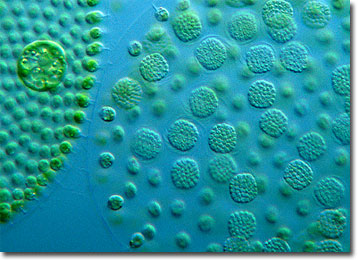Wim van Egmond
Volvox Sperm Packets
Many protozoa and algae reproduce solely through asexual means. Some species, however, like those of the colonial genus Volvox, are also capable of sexual reproduction.

The cells in a Volvox colony exhibit a certain amount of differentiation. The individuals towards the front of the colony feature enlarged eyespots, providing them with a greater ability to lead the colony toward sunlight. A small number of specialized cells near the rear of the colony, however, are responsible for reproduction. In the asexual mode, these gonidia subdivide through the process of mitosis into daughter cells, which accumulate to form small daughter colonies within the parent colony. Produced inside out, the daughter colonies invert themselves before the parent colony disintegrates, causing them to be released into the water where they become independent colonies. Also, before they exit the parent colony, some daughter cells may also undergo mitosis, resulting in granddaughter colonies.
In contrast, to facilitate sexual reproduction, some of the gonidia of a Volvox colony may undergo repeated divisions that result in round or oval-shaped sperm packets. This process is believed by many to cause the colony to produce a pheromone that causes other Volvox colonies in the surrounding area to become sexually active. If accurate, the probability that the sperm packets will quickly find female Volvox colonies when they are released into the water is increased. Once an appropriate colony is located, the sperm packet enters with the help of enzyme secretions and, when inside, breaks up so that individual gametes are free to fertilize nearby eggs. It is important to note, however, that it is also possible for Volvox to produce both eggs and sperm packets in a single colony, enabling them to sexually reproduce without the involvement of other individuals. In either scenario, successful fertilization generally results in the formation of a resting zygote that features a thick, spiny cell wall that can withstand harsh environmental conditions.
BACK TO WIM VAN EGMOND GALLERY
